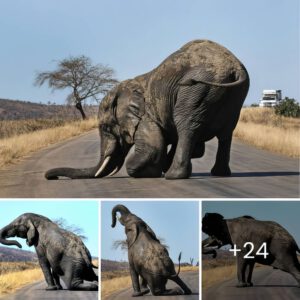In the heart of Mugie Wildlife Conservancy, a majestic adult male elephant recently faced a challenging health ordeal.
The elephant, visibly distressed, struggled with mobility issues, particularly in its left front leg’s carpal joint, which was swollen and weak.

Despite these challenges, the elephant appeared in decent physical condition, with minor injuries surrounding the affected area.
Providing Care to the Immobilized Elephant
As the ailing elephant slowly moved slowly through a dense thicket, conservationists took a compassionate approach to address its condition.

An 18mgs dosage of etorphine Hcl, delivered through a 3ml Dan-inject dart, was administered.
Within approximately 6 minutes, the elephant succumbed to the tranquilizer, gracefully descending into a state of lateral recumbency.
Upon close examination, apparent traumatic wounds near the swollen leg were observed. The affected leg, suspected to have a partial fracture or dislocation around the carpal joint, caused inflammation and intense discomfort, hindering the elephant’s movement. The source of the injury remained uncertain.

To ensure the elephant’s well-being, a treatment plan was initiated. Calcium, Vitamin B12, and dexamethasone were administered to alleviate nerve issues and reduce joint pain.
Furthermore, a long-lasting antibiotic, Betamox®, was given intramuscularly to address potential internal infections.
Post-treatment, the elephant was gently awakened from anesthesia using a combination of 48mgs of diprenorphine Hcl and 50mgs of Naltrexone through the superficial ear vein.

Within two minutes, the elephant stood up, displaying signs of relief as it moved away from the treatment area.
Despite the initial uncertainty surrounding the elephant’s outlook due to pain and immobility, the creature exhibited a healthy appetite. It remained close to a water source, providing hope for recovery.
Thankfully, the elephant has progressed and relocated from the treatment area.
Read more Elephant News.





